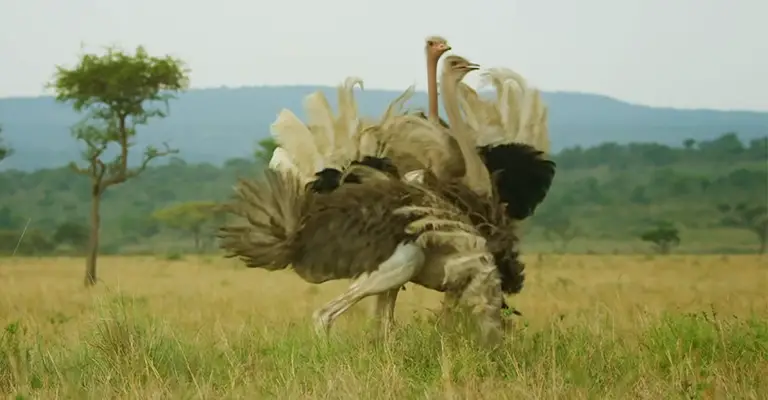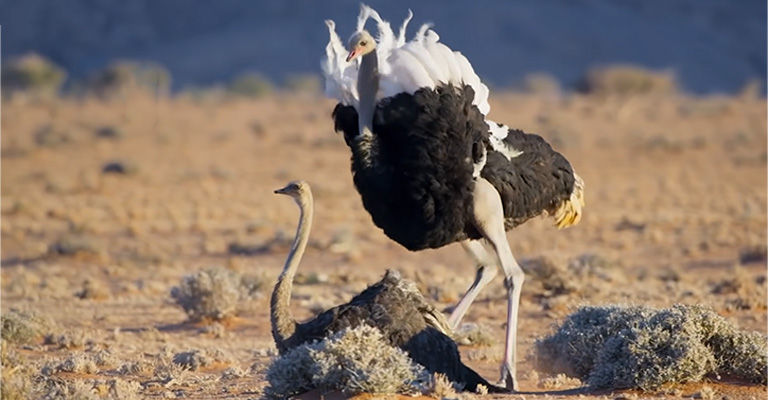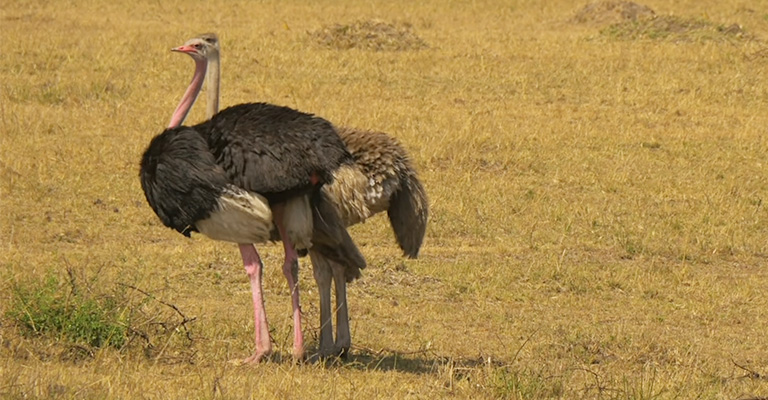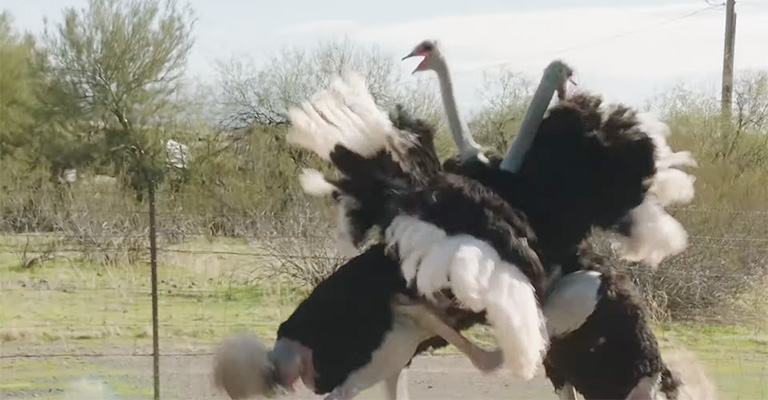When the towering giants of the avian world engage in combat, a spectacle unfolds that is as mesmerizing as it is intriguing.
Ostriches, known for their impressive speed and distinctive appearance, can be formidable opponents when locked in battles with their own kind.
The question of what happens when ostriches fight each other takes us into the heart of their complex social dynamics and survival strategies.
From dramatic displays of dominance to potential risks and consequences, these confrontations offer a glimpse into the intricate workings of nature’s grand theater.

What Happens When Ostriches Fight Each Other?
Ostriches are fascinating birds that have some unique behaviors and adaptations that help them survive and thrive in their habitats.
One of them is fighting with each other, which may seem violent or brutal to us. However, there are some facts and reasons behind these fights, and here are some of them:
Dominance and Territory
Ostriches are social animals that live in groups of up to 50 individuals during the breeding season. They communicate with each other through vocalizations, body postures, and displays.
However, they also compete with each other for dominance and territory, especially during the breeding season around March/April.
Dominant males fight for harems of 2 – 7 females with which to mate and defend their territory by patrolling and displaying and making loud booming calls. They also inflate their bright pink necks to show their status and aggression.
Kicking and Pecking
Ostriches rely on their powerful legs and sharp claws for defense. They also use them as weapons and can deliver powerful kicks to fend off predators or rivals. Ostriches face their opponent and kick forwards and downwards with one leg at a time.
They cannot kick backward, like a horse, for example. Forward kicks bring their huge claws into play, and those sharp, 4-inch (10-centimeter) long claws can break the skin and cause serious injuries. Ostriches also use their beaks to peck at each other’s eyes, necks, or chests.
Fight To The Death
Ostrich fights are often territorial disputes or battles for dominance. Their fights can be intense and can result in serious injuries or even death.
Ostriches do not usually fight to the death, although fights can last for minutes, with each bird trading many vicious blows. Ostriches face each other while kicking forward and downward, raking across their opponent’s chest and thighs.
The weaker ostrich only needs to turn and run away when it has had enough and concedes to the more dominant individual.
Breeding Season

Ostriches are generally most aggressive during the breeding season, a time when males fight amongst each other for dominance and females.
Breeding male ostriches are also quick to defend their nest sites from potential threats, including humans. The breeding season lasts from March to September in southern Africa and from October to March in eastern Africa.
During this time, ostrich fights are more frequent and more violent than usual.
Fight Differently Depending On Their Sex
Ostriches have different plumage patterns depending on their sex and age. Male ostriches have black body feathers with white wing tips and tail feathers, while female ostriches have gray or brown body feathers with white spots.
Juvenile ostriches have brown or gray plumage with black stripes. Their plumage helps them camouflage with their environment, as well as display their gender and maturity.
Ostriches also fight differently depending on their sex. Male ostriches tend to fight more aggressively and violently than females, using their legs and claws more often.
Female ostriches tend to fight more defensively and cautiously than males, using their beaks more often.
Fight Differently Depending On Their Age
Ostriches have different leg muscles depending on their age. Juvenile ostriches have smaller and more slender muscles than adult ostriches, which may reflect their different locomotor demands and abilities.
Ostriches also fight differently depending on their age. Juvenile ostriches tend to fight more playfully and less seriously than adults, using their legs and beaks more gently.
Adult ostriches tend to fight more seriously and less playfully than juveniles, using their legs and beaks more forcefully.
Fight Differently Depending On Their Habitat

Ostriches are highly nomadic and will travel long distances to find suitable food and water.
They have adapted to various habitats across Africa, ranging from open arid and semi-arid regions such as deserts, savannas, and grasslands to more vegetated areas such as woodlands and scrublands.
Ostriches prefer habitats that have enough space for them to run, forage, and nest, as well as access to water sources. Ostriches also fight differently depending on their habitat. Ostriches that live in open habitats tend to fight more openly and visibly than those that live in vegetated habitats.
Ostriches that live in vegetated habitats tend to fight more covertly and stealthily than those that live in open habitats.
Differently Depending On Their Personality
Ostriches are curious and intelligent animals that have a range of emotions and preferences. They can be friendly or aggressive, shy or bold, playful or serious, depending on their mood or situation.
Ostriches also fight differently depending on their personality. Ostriches that are more aggressive tend to fight more frequently and fiercely than those that are more friendly.
Ostriches that are more shy tend to fight more defensively and cautiously than those that are more bold.
Fight Differently Depending On Their Opponent
Ostriches have a complex social structure that requires cooperation and coordination. They communicate with each other through vocalizations, body postures, and displays.
They also recognize each other as individuals and form bonds and hierarchies within their groups. Ostriches also fight differently depending on their opponent.
Ostriches that are more familiar with each other tend to fight more respectfully and peacefully than those that are more unfamiliar. Ostriches that are more similar in size and strength tend to fight more evenly and fairly than those that are more dissimilar.
These are some of the facts and reasons behind ostrich fights.
What To Do When Ostriches Fight With Each Other?

Ostriches are fascinating birds that have some unique behaviors and adaptations that help them survive and thrive in their habitats.
One of them is fighting with each other, which may seem violent or brutal to us.
However, there are some facts and reasons behind these fights, and here are some tips on what to do when ostriches fight with each other:
Keep Your Distance
Ostriches are the largest and heaviest living birds, and they can run very fast and kick very hard. They can inflict serious injuries or even death on their opponents, whether they are other ostriches, predators, or humans.
If you see ostriches fighting with each other, do not approach them or try to intervene. Keep a safe distance and observe them from afar.
Do Not Provoke Them
Ostriches are generally not aggressive towards humans unless they feel threatened or challenged. They may perceive you as a potential threat or rival if you make loud noises, sudden movements, or eye contact with them.
Do not provoke them by doing any of these things or by throwing objects at them or trying to touch them. Stay calm and quiet, and avoid any actions that may trigger their aggression.
Do Not Feed Them
Ostriches are omnivorous, which means they eat both plants and animals. They can consume up to 8 pounds of food per day, including grasses, seeds, fruits, flowers, insects, lizards, snakes, rodents, and carrion.
They also swallow pebbles and sand to help them digest their food. Do not feed them anything that is not part of their natural diet, as it may harm their health or make them more aggressive.
Feeding them may also attract more ostriches to the area, increasing the chances of fights breaking out.
Do Not Interfere With Their Nests
Ostriches are most dangerous during the breeding season, a time when males fight amongst each other for dominance and females. Breeding male ostriches are also quick to defend their nest sites from potential threats, including humans.
The breeding season lasts from March to September in southern Africa and from October to March in eastern Africa. During this time, ostrich fights are more frequent and more violent than usual.
Do not interfere with their nests or eggs, as they may attack you fiercely to protect them.
Seek Shelter If Possible
If you are in an area where ostriches are fighting with each other, and you cannot escape or avoid them safely, seek shelter if possible.
Look for a nearby building, vehicle, tree, or fence that can provide you with some protection from their kicks and pecks.
Ostriches cannot fly, but they can jump over obstacles up to 4 feet (1.2 meters) high. Make sure your shelter is high enough or sturdy enough to keep them out.
Run Away If Necessary
If you are in an open area where ostriches are fighting with each other and you have no shelter available, run away if necessary.
Ostriches can run at speeds of up to 43 miles per hour (70 km/h), but they cannot sustain this speed for long distances.
You may be able to outrun them if you have enough stamina and space. Run in a zigzag pattern to make it harder for them to chase you. Do not run in a straight line, as they can easily catch up with you.
Lie Down If Cornered
If you are cornered by an ostrich that is fighting with another ostrich, lie down if possible. Ostriches have poor depth perception and may not notice you if you are lying flat on the ground.
They may also lose interest in you if you appear dead or submissive. Cover your head and neck with your arms to protect yourself from their kicks and pecks. Stay still and quiet until they leave you alone.
Fight Back As A Last Resort
If you are attacked by an ostrich that is fighting with another ostrich, fight back as a last resort.
Use a long weapon if you have one, such as a pole, rake, broom, or branch. Keep as far out of reach of its legs as you can since ostriches can kick hard enough to kill a lion.
Aim for its neck or wings if possible, as these are its weakest body parts. Damage to its wings may marginally improve your chances of running away in a zigzag fashion if you are forced to retreat.
Seek Medical Attention If Injured
If you are injured by an ostrich that is fighting with another ostrich, seek medical attention as soon as possible. Ostriches can cause serious injuries such as broken bones, punctured organs, or infections.
You may also need a tetanus shot or antibiotics to prevent complications. Do not ignore or delay treatment, as your condition may worsen over time.
These are some of the tips on what to do when ostriches fight with each other.
FAQ
Ostriches engage in aggressive displays to establish dominance and hierarchy within their group.
This can involve intense posturing, fluffing of feathers, and chasing each other. If the conflict escalates, they may use their powerful legs to deliver swift kicks, potentially causing injuries.
Ostriches fight to establish social order, especially during mating season. Dominant individuals gain priority access to mates and resources, increasing their chances of passing on their genes.
These confrontations are a way to ensure reproductive success and maintain group stability.
While not constant, fights can occur frequently during mating periods. Ostriches also engage in less intense displays of aggression to reinforce their positions within the social hierarchy and to defend territories or resources.
The outcome is usually determined by one ostrich displaying more dominant behavior, causing the other to back down.
The one with the more powerful displays of aggression, which might include fluffing feathers and aggressive posturing, often emerges as the victor.
Fights can be risky as ostriches have powerful legs armed with sharp claws. Kicks can cause serious injuries, fractures, or even death.
While these battles are crucial for maintaining order, they also serve as a reminder of the high stakes involved in the competition for resources and reproductive success.
Conclusion
When ostriches clash, a dramatic contest for dominance and survival unfolds. The rituals of intimidation, posturing, and fluffing of feathers create an awe-inspiring display of natural instincts at play.
While these confrontations often serve to establish hierarchy and ensure reproductive success, they also carry risks, as injuries can result from the powerful kicks and blows exchanged.
The battles of ostriches reflect the complexity of their social structure and the primal drive for survival in the animal kingdom.
Witnessing these encounters reminds us of the untamed beauty and unyielding force of the natural world, where even the most majestic creatures engage in struggles to secure their place in the hierarchy of life.